Main menu
Common skin conditions

NEWS
Join DermNet PRO
Read more
Quick links
Author: Vanessa Ngan, Staff Writer, 2002. Updated by Dr Jannet Gomez, October 2016; Dr Adam Dedat, SHO and Dr Ian Coulson, Dermatologist, United Kingdom, July 2022.
Introduction
Demographics
Causes
Clinical features
Diagnosis
Complications
Treatment
Prevention
Vaccination against chickenpox
Chickenpox is a highly contagious viral infection that causes an acute fever and blistered rash, mainly in children. Chickenpox is also known as varicella.
The name may be derived from the French term for chickpea, chiche pois. Another theory is that the word 'chicken' was derived from a slang term for 'child'.

Chickenpox on back

Chickenpox
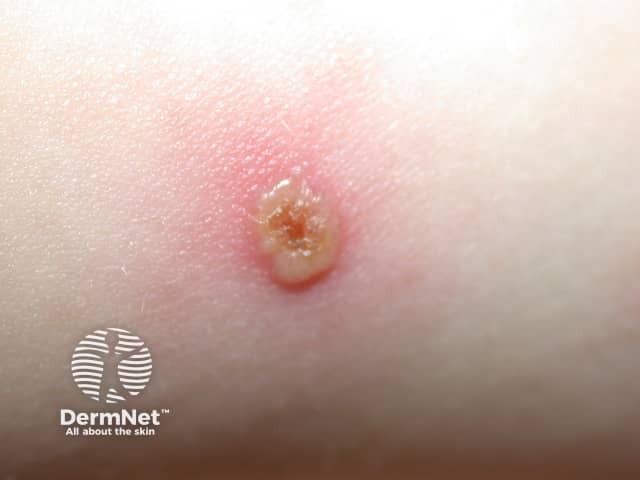
Chickenpox
Chickenpox occurs worldwide, affecting persons of all races, sex and age. Most cases occur in children before they are ten years of age.
Once a person has had the chickenpox infection, it is unlikely he or she will get it again, as it confers lifelong immunity.
Immunocompromised individuals are susceptible to the virus at all times and should take measures to prevent or modify the course of the disease if there has been exposure to the virus.
Chickenpox is caused by primary infection with the varicella-zoster virus, of the Herpesviridae family. This virus is sometimes called herpesvirus type 3.
Chickenpox is highly contagious and is easily spread from person to person by breathing in airborne respiratory droplets from an infected person's coughing or sneezing or through direct contact with the fluid from the open sores.
A person who is not immune to the virus has a 70–80% chance of being infected with the virus if exposed to someone in the early stages of the disease.
In children, chickenpox usually begins as itchy red papules progressing to vesicles on the stomach, back and face, and then spreading to other parts of the body. Blisters can also arise inside the mouth
The spread pattern can vary from child to child. There may be only a scattering of vesicles, or the entire body may be covered with up to 500 vesicles. The vesicles tend to be very itchy and uncomfortable.
Some children may also experience additional symptoms such as high fever, headache, cold-like symptoms, vomiting and diarrhoea.
Chickenpox is usually more severe in adults and can be life-threatening in complicated cases. Most adults who get chickenpox experience prodromal symptoms for up to 48 hours before breaking out in the rash. These include fever, malaise, headache, loss of appetite and abdominal pain. Chickenpox is usually more severe in adults and can be life-threatening in complicated cases.
The blisters clear up within one to three weeks but may leave a few scars. These are most often depressed (anetoderma), but they may be thickened (hypertrophic scars). Scarring is prominent when the lesions get infected with bacteria.
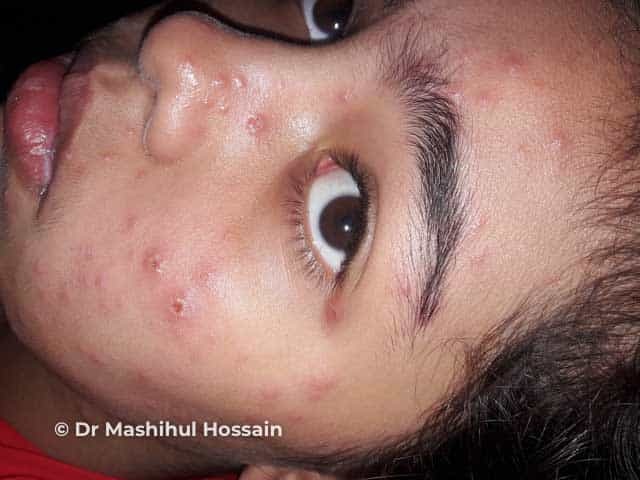
Chickenpox on face

Chickenpox
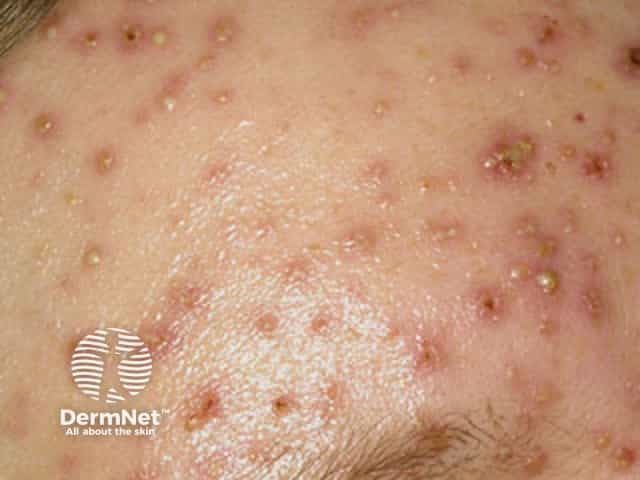
Chickenpox
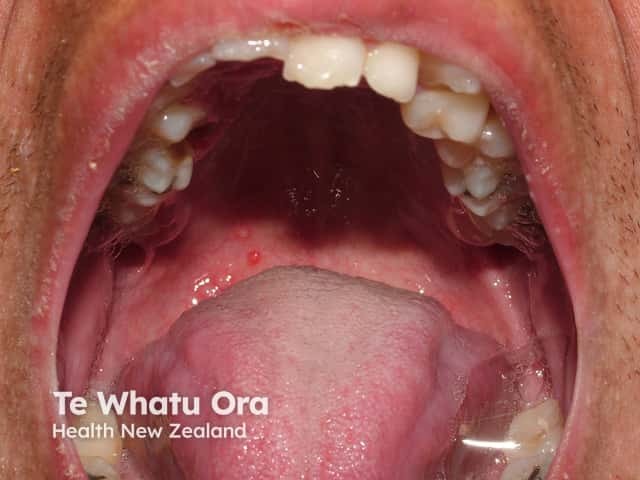
Chickenpox

Chickenpox
See more images of varicella ...
Diagnosis of chickenpox is usually made on the presence of its characteristic rash and the presence of different stages of lesions simultaneously. A clue to the diagnosis is in knowing that the patient has been exposed to an infected contact within the 10–21 day incubation period. Patients may also have prodromal signs and symptoms. See also chickenpox pathology.
Laboratory tests are often undertaken to confirm the diagnosis.
In healthy children, chickenpox infection is usually an uncomplicated, self-limiting disease. Complications may include:
Some complications are more commonly seen in immunocompromised and adult patients with chickenpox.
Varicella in pregnancy
Perinatal varicella
Shingles (herpes zoster)
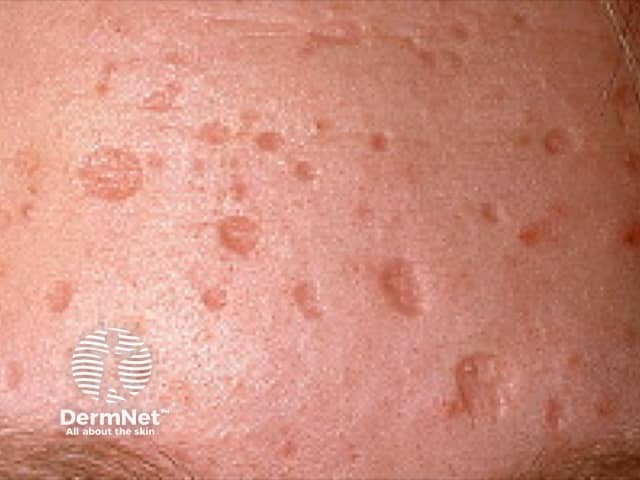
Scars from chickenpox
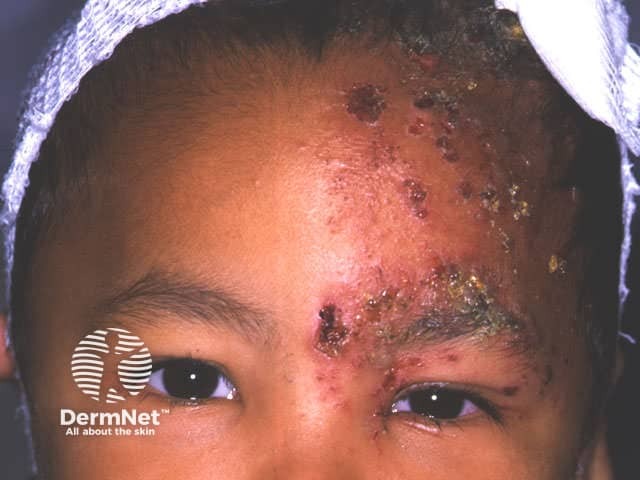
Herpes zoster
For most healthy patients with chickenpox symptomatic therapy is usually all that is required.
Immunocompromised patients with chickenpox need intravenous treatment with the antiviral aciclovir.
In cases of inadvertent exposure to the virus, varicella-zoster immune globulin if given within 96 hours of initial contact can reduce the severity of the disease though not prevent it. This is used where there is no previous history of chickenpox (or the patient has no antibodies to the varicella-zoster virus on blood testing) in pregnancy, in the first 28 days after delivery, and in immune deficient or immune-suppressed patients.
A person with chickenpox is contagious 1–2 days before the rash appears and until all the blisters have formed scabs. This may take 5–10 days. Children should stay away from school or childcare facilities throughout this contagious period. Adults with chickenpox who work among children should also remain home.
It can take 10–21 days after contact with an infected person for someone to develop chickenpox. This is how long it takes for the virus to replicate and come out in the characteristic rash in the new host.
As chickenpox may cause complications in immunocompromised individuals and pregnant women, these people should avoid visiting friends or family when there is a known case of chickenpox. In cases of inadvertent contact, see your doctor who may prescribe special preventive treatment.
Vaccination is available for chickenpox and is highly recommended.
Chickenpox is highly preventable by vaccination with live attenuated varicella vaccine. The vaccine is subsidised ("scheduled") for infants aged 15 months in New Zealand as well as non-immune individuals who are immunosuppressed or are in other special groups. If in New Zealand, refer to the Immunisation Advisory Centre for up-to-date information.